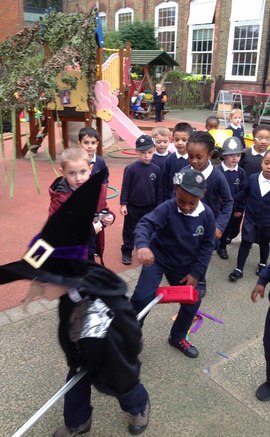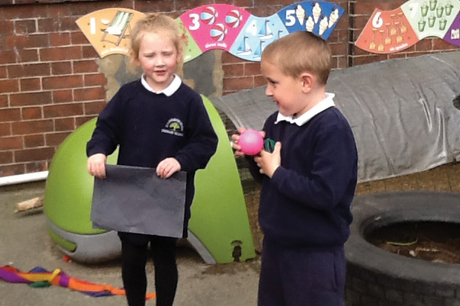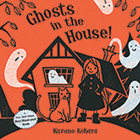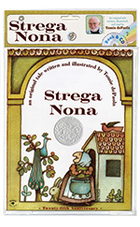
Our topic on witches started with the Reception children looking at books ranging from Hansel and Gretel to Winnie the Witch. It was clear from the start that the subject had grabbed the attention and imagination of a core group of children. We observed lots of play based on the Hansel and Gretel story and so decided to extend it into the playground by creating a sweet house and forest.
It was at this stage that we started to pose problems and make suggestions to develop the children’s play. First up for discussion was how to free Hansel and Gretel from the witch. The children decided that the solution was a magic potion that would turn the witch into a frog. When I explained that I didn’t know how to make a potion, the children set about writing recipes and finding the ingredients.
With their potion now prepared, I pointed out that our next problem was how to find the witch’s house. Here, the children drew on the story and suggested laying a path of stones to find her. They then drew and labelled maps of the playground to mark a way through the forest to get to the witch’s house. I took the opportunity to involve some of the children who were reluctant mark-makers by encouraging them to help with the maps.
By now there was a great deal of excitement, and the children collected their potions and maps to go and confront the witch. As expected, they managed to free Hansel and Gretel and turn the witch into a frog. However, not content with this, the children decided they wanted to warn others of the dangers of going to the witch’s house.
I showed them some signs and symbols that represented danger and the children created their own signs to display around the house. This was another activity that inspired our reluctant mark-makers to become involved, so to extend their interest we decided to create a bit of mystery and have a ‘real witch’ visit the setting.

IN A FLASH
One afternoon during a very peaceful phonics session, I saw a flash of black material go past the window. I set the stage by asking the children if they had seen it and pretended to be distracted by what I had seen outside.
My behaviour sparked the children’s interest immediately. Then all of a sudden a witch came into our classroom on her broomstick, cackled, went through to the next class and disappeared into the playground.
The event sparked lots of questions about who she was and what she was doing at our school. We explored how the children felt and, to allay any fears, we invented the laser finger to protect us from any witches that might be nearby. We also encouraged parents to share stories about witches to make the children feel even safer about exploring the topic.
It then became the children’s mission to find out who the witch was. I explained that one way to try to identify someone was to create a wanted poster with a description of the person. After making their posters, the children felt that more investigation was needed. They surmised that the witch had to be one of the adults in the school and set about finding who it was by dressing as police officers, going around the setting asking the adults questions and writing their observations in their notebooks.
Another group of children decided to go on an adventure to find the witch and together wrote a list of what they would need. They made packed lunches for themselves and set off to find the witch, singing ‘We’re going on a witch hunt’. After much investigation, the children reasoned that the witch had to be the nursery teacher because she wore black clothes and was the same size as the witch.
By this point, the learning outcomes from the project related principally to Communication and Language, Personal, Social and Emotional Development, Literacy and Expressive Arts and Design, so we felt we needed to incorporate more numeracy into the children’s play.
MISSING NUMBERS
To set the scene, I removed some of the numbers from our number line the night before and was standing looking at it when the children arrived the following morning. As this was not in my usual place to greet them, they came straight over to see what was happening.
I explained that some of the numbers were missing and I couldn’t find them anywhere. Immediately, one of the children said that the witch had taken them. This prompted a range of questions: ‘Why had the witch taken them?’, ‘Where were they?’, and ‘Which numbers were missing?’
Our first job was to order the numbers and identify which ones were missing. We then discussed why the witch might have taken those numbers specifically. The children felt that the witch didn’t know her numbers and that she was trying to learn them. They decided that they should make a number line for her so that she could practise counting. This resulted in a group of children writing numbers 0-20 in order and leaving them out for her to take.
Amazingly, the next day, the number lines were gone and the numbers that we had lost were back in their right place.

THE QUEEN AND THE WITCH
Over time, we have observed the children returning to their witch play to put new topics and themes into context. During our space topic, we made telescopes to look at the moon.
One child, while looking through their telescope, said, ‘I can see a witch. She has black curly hair.’ And when we celebrated the queen’s birthday, a group of children role-played a witch locking the queen in a cage and trying to feed her slug and worm cake for her birthday.
The children produced maps to locate the queen along with lists of things that they would need to free her. Throughout, they were able to discuss and negotiate each other’s roles in their play.
Observing how the children use their existing knowledge to make sense of new things really highlighted the importance of our pursuing their ideas and interests so they can derive the greatest learning from the experiences we offer them.
BOOK CORNER 
- Winnie the Witch by Valerie Thomas and Korky Paul – Since her debut in 1987, Winnie and cat Wilbur have been on many adventures. Recent titles includeWinnie’s Haunted House.
- Teeny-Tiny and the Witch-Woman by Barbara Walker and Michael Foreman – In this variation of Hansel and Gretel, three brothers ignore their mother’s warnings not to play in the forest.
- Ghosts in the House! by Kazuno Kohara – This little witch girl knows how to take care of ghosts: catch them, launder them and use them as bed sheets.
- Strega Nonaby Tomie dePaola – Grandma Witch is the source for potions and comfort in her Calabrian town. Big Anthony recites a verse over Grandma’s
magical pasta pot – with disastrous results.
- Raven Child and the Snow-Witch by Linda Sunderland and Daniel Egneus – Anya lives in the shadow of the icy glacier where the Snow-Witch reigns. When the witch captures her mother, she and her father set off to rescue her.
- Room on the Broom by Julia Donaldson and Axel Scheffler – As animals retrieve the witch’s belongings, each hitches a ride on the broom – then it snaps in two…
- Meg and Mog by Helen Nicoll and Jan Pienkowski – Witch Meg’s spells always seem to go wrong, in this and her 20-plus other adventures with her cat Mog.
MORE INFORMATION
Gainsborough Primary School is one of a group of schools involved in The Newham Reception Innovation Project, aimed at raising the quality of play-based provision in Reception classes. To find out more, see ‘In character’ and ‘Play time’, both at www.nurseryworld.co.uk









